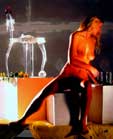Aesthetics and Meaning in Glass Art
M.A. paper, Merle Kannus 2002 |
Short Summary
The subject of this paper is the mental space surrounding glass art today. The creative standpoints of various authors are discussed along with the question: what is the significance of glass as an art medium - in the case of artists inside as well as those outside the glass community. My work is also an attempt to find verbal equivalents to the visual language of glass art. I consider the problems of meaning, aesthetics and ethics; also the content behind the terms art, glass art, applied art etc.
During my research, 6 basic aesthetic principles took form and found their representatives:
 Diet Ditman: drawing on glass
Diet Ditman: drawing on glass
1. Glass-as-glass
This chapter deals with the trend that gives primacy to the material and cultivates respect for its intrinsic qualities. The will of the author is not denied; rather, the author is expected to cooperate with the material's nature. Forced decoration and "unnatural" solutions are the faults held in contempt. The aesthetics of hot, flowing glass is illustrated by the words and deeds of John Ruskin, William Morris, Maurice Marinot, Harvey Littleton, and Erwin Eisch. Cold glass in its meditative, austere and classical form is represented by Frantisek Vizner, Toshio Iezumi, Timo Sarpaneva, and Bert Frijns. Since the domineering quality of the material can become a problem for glass artists, some attention is given to discussions over the status of art glass in the broader art world, and also those considering aesthetic issues.
 Toshio iezumi: Surface
Toshio iezumi: Surface
2. Absolutely beautiful
In the glass paradigm, this is an approach where instinct and desire are given full reign. The deeply human strive to decorate, along with born-in horror vacui, have given birth to numerous colourful, glitzy and exaggerated works of art. Joseph Paxton, Èmile Gallè, Louis Comfort Tiffany and Renèe Lalique are among the classical examples; the postwar avant-garde of deliberately bad taste includes the works of Ettore Sottsass, Jeff Koons, Sunny van Zijst, Jamex & Einar de la Torre. On the bright side, naivety - whether natural or learned - makes its comeback in the art of Liza Lou, Ginny Ruffner, Josh Simpson, Catherine Rahn and Dale Chihuly.
 Borek Sipek: CC 2001
Borek Sipek: CC 2001
3. Futurism
The iconography of science fiction movies, laboratory landscapes, perceptual illusions, light and atmospheric phenomena forms a utopia, or dystopia, of a future that is now. Glass becomes a metaphor for vision, knowledge, technology, civilization, but also for waste and excess. Burning the bridges to the past was the aim of Paul Scheerbart, Bruno Taut and Frank Lloyd Wright; the space age inspired poetic comments from Morris Graves, Yan Zorichak and Jean Nouvel. James Carpenter merges art with technology in a true Renaissance manner; Eric Starosielski and Andrew Pepper rediscover the human element in the highest of hi-tech. Science also inspires irony: Eve Andrèe Laramèe, Jill Reynolds, Clemens Weiss, Donald Lipski, and Richard Meitner have proven this, while questioning modern man's beliefs and warning of the dangers of technological progress. On the borderline between the scientific and the artistic ways of cognition, we find Leopold & Rudolph Blaschka, Allan McCollum and RIchard Harned. To see is to believe... or is it?; examples by Taliaferro Jones, Diet Wiegman, Steve Weinberg, Roxanne Blanchard and Victor Vasarely.
 Josh Zimmerman: Future Fetish
Josh Zimmerman: Future Fetish
4. The Invisible Canvas
What qualities does glass add to depictive and narrative art, and vice versa? Brian Clarke & Linda McCartney, Sheryl Rubenstein and Therman Statom present three different approaches.
 Brian Clarke & Linda McCartney: Jerry Stickles
Brian Clarke & Linda McCartney: Jerry Stickles
5. The Glass Body
Physiological associations brought about by the liquidity and brittleness of glass are featured in the art of Louise Bourgeois, Kiki Smith, Mary Shaffer, Maureen Conner, Michael Aschenbrenner, Jörg F. Zimmerman, Chris Wilmarth, Piergiorgio Tempesti, Walter Zimmerman, and Philippe Avila. Judy Hill and Maria-Magdalena Campos-Pons present an idea of a spirited, living, thinking body. In the end of the chapter there's a brief section on (the artists') own bodily experiences of glass.
 Kiki Smith: Black Rain
Kiki Smith: Black Rain
6. The Shards
As Th. McEvilley notes, glass has, until recently, found more acceptance in the art world when broken, not when whole. Marcel Duchamp, Danny Lane, Gordon Matta-Clark, Francesco Torres, Bernadette Cotter, Maya Lin and Maura Sheehan are among the famous glassbreakers. Fred Tschida, Buster Simpson and Richard Posner believe there's hope and rebirth in wreckage. Using second-hand glass, they initialize a new cycle of exchange and circulation of values in society.
I must confess that my choice of authors represents a personal point of view, giving preference to some artists while neglecting others. In search for material, I valued the artists' own statements foremost, trying to find as many of those as I could. The critics, naturally, have been more talkative, so I had to rely on their help as well.
My work presents a survey of what exists and has been done; I'm not making any predictions as to the future of glass and to what aesthetics it may follow.
 Roul Kurvitz: Cathedral
Roul Kurvitz: Cathedral
| <<< index | <<< cv | <<< glass | <<< photo | <<< installations | <<< design | <<< text |